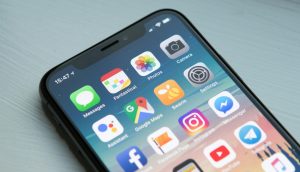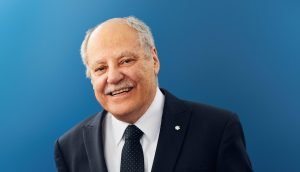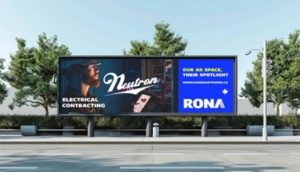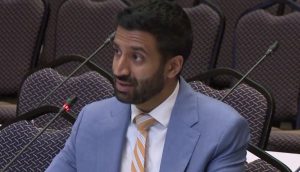New York has always been the epicentre of the ad world in North America, but even in the six short years since the industry first came together to orchestrate Ad Week, things have changed radically on many fronts. Gaming is getting more play this year, mobile scored a summit, trust is on the agenda, as is social impact, and climate change has its own symposium.
However, media remains at the core of the hottest shift in ad circles these days, so it’s fitting that two two-day media events kicked off Ad Week in New York yesterday.
According to Interaction, a new GroupM global study, Internet advertising will account for about 15% of global measured advertising spending in 2010, up from an estimated 13% of this year’s pie, and up 11% over the previous year. And online outperformed other media through the recession, so no wonder the media streams of Ad Week festivities are digitally obsessed.
IAB’s MIXX conference/expo is entitled ‘Fueling the Creative Revolution in Interactive Advertising,’ and OMMA’s online media, marketing and advertising conference/expo goes under the cheeky billing of ‘The New Socialism: Marketing’s Greatest Opportunity? Or the Final Nail in Big Media’s Coffin?’
Luckily, the two confabs are being held mere blocks apart, so MiC can bring you tidbits from the stages of both.
Over at OMMA, organized by MediaPost, the day started off tabulating ‘The state of online media, marketing and advertising by the numbers.’
After ComScore co-founder and CEO Magid Abraham mapped out the aggressive growth of online media and where it’s headed, a marketer from Coca-Cola in the audience asked if social media is providing exponential audience reach beyond mass, meriting all the effort. Abraham replied that they do see incremental reach to TV, because when you look at effective TV reach (3+ impressions) you reach about 60%, and that when you add in social media, since there’s a lot of young people not watching TV – or maybe just watching it online – you could reach 80%, which is why advertisers are evolving their digital strategy.
Ford: from zero to social brand hero
One morning keynoter, Scott Monty, Ford Motor Company’s global digital and multimedia communications manager, is doing just that. Monty’s goal was to make Ford the most social auto brand in three years, and did it in six months. He shared Ford’s global media strategy in a presentation fittingly called ‘Social Media Strategy: From Zero to 60.’
Monty, who coined the expression ‘tweet-up,’ explained Ford’s motivation for jumping into the digital fray by citing growing consumer distrust of companies and the credibility of people like themselves and third party experts.
He also says that structural changes at Ford set the stage for success in this realm, explaining that leadership and a strong plan is key to staying on course. Fortuitously, in 2006 Ford hired from outside its industry, bringing in CEO Alan Mullaly, who put a strategic plan in place designed to align and cut out non-core business. And he’s not only on board, he’s on Twitter. After that, according to Monty, 90% of success in social media is just showing up.
Monty’s tips for taking brands into the social scene include: ‘step up your game, and be the most accessible you can be. A lot of it is just about being open. There’s lots of examples of people getting cute and gaming the system, but people will figure out that they’ve been smokescreened.’ His sentiments about how to approach consumers socially – ‘they appreciate honesty and authenticity’ – came up time and again from various speakers over the day.
The game plan entailed pretty much every social tool out there, and utilized TheFordStory.com, which was originally put together around the congressional hearings, as the social media hub. Since, they’ve logged over 1.2 million views on Ford YouTube videos, expanded presence on social networks, have numerous Twitter feeds and a Faceboook app called Wespeakgreen (lightly branded by Ford), where fans can share green tips. For three weeks the top tip was from a guy who used his hot dog water to water plants.
Meanwhile, a Mustang site lets users customize a car, illustrating the requisite social brand attititude: to be ‘no longer afraid of what people will do with it if we don’t lock it down.’
Ford has also been giving vehicles to bloggers to use for interesting endeavours. Monty gave a car to a couple planning an untraditional wedding road trip in which they visited people they would have invited to a gigantic wedding and instead solicited one-on-one marriage advice. Ford also helped them sort their married surname debate. They became Mr. and Mrs. Ford.
And for the ‘Fiesta Movement,’ Ford opened up to social-minded individuals and asked them what they would do if they were given a car for six months. The response was 4,000 candidates for 100 spots, and the resulting blogging led to 38% recognition for a vehicle that didn’t exist in the market. Fiesta fan feedback was also given to engineers, so Monty says ‘it’s an exercise in crowdsourcing as well.’
While Twitter efforts have been linked to sales – as evidenced in this tweet: ‘I only bought a Ford because of Twitter. I’m serious’ – Monty prescribes a social rather than sales-y approach: ‘don’t burst into a cocktail party, hand out your business cards and leave.’
The ongoing drive to top social standing entails retraining staff and rolling social media outreach into other functions. Monty says they plan to ‘make it part of a lot of people’s regular jobs,’ and is looking to create digital ambassadors within the rank and file, connecting with enthusiasts to find that digital 1% to prep via training and guidelines.
And his final bit of advice is to be ‘constantly listening.’
When asked about the greatest friction he encounters, Monty says it’s time. ‘It’s capacity, it’s very difficult to scale,’ and concludes, wryly, ‘I’ve doubled my staff, there’s now two people doing social media.’

Unilever: a lot more listening
OMMA also hosted a panel exploring ‘The New Socialism – Marketing Industry Growth Engine?’ moderated by Media Link chair and CEO Michael Kassan, who described the climb of social media in melodramatic Hollywood movie mode: ‘first it took our children, then it came for us, if our pets could type they’d be on it,’ adding darkly, ‘something wiki this way comes.’
When asked the million-dollar question: ‘how does it fit in your overall channel mix?’ Rob Master, North American media director, Unilever, replied, ‘we’re still evolving with it.’ Admitting that several years ago he was dubious about there being a role for mayo and deodorant in social media, fast forward and it’s now a built-in element. ‘Now we’re looking at the fabric of our campaigns and everything underneath that’s social.’
Another element Unilever is still evaluating is the right metrics. ‘Social is a whole other avenue, we don’t have a firm grasp of ROI. We’re setting up a host of metrics to allow us to benchmark. One of the biggest things Unilever is doing is a lot more listening. Every 60 seconds, four conversations are started about butter or margarine.’
Speaking on the same panel, Phil Cowdell, head of Mindshare NA, piped in that they need a wooing metric. ‘We need to learn to woo. Ultimately we have to get to sales, but it will depend on personal impressions, prejudices, beliefs about a brand. We need to bond them to the brand.’
On the question of ‘is it worth it?’ Master replies, ‘it’s something we’re watching very closely. We go back to the consumers and ask how they respond to our programs. In the beginning it’s going to be a lot of work to restructure your organization in terms of media and creative as well as brands to address the issue.’ Unilever’s social space is helmed by a cross between its media, PR, digital and AOR partners, the 800-number folk, legal and the brands themselves, all working cross-functionally, internally and from an agency POV.
Cowdell also pointed out that the working mayhem wrought by social media is a further ‘disconnect on the business compensation model, it brings us closer and closer to the abyss.’
To get up to speed on the marketing side of that abyss, Master says the last Unilever offsite had a day and half on social media, and is doing Twitter training for the entire org. ‘You need to stay light on your feet, very nimble, and harness the power of the young people in your organization – we do things like reverse mentoring.’
P&G: creative counts
Over at the MIXX event, Lucas Watson, P&G global team leader, digital business strategy, talked about the creative side of working in the digital space. The man with 300+ brands in his digital care entitled his thoughts on the matter ‘Creative Counts.’ Watson says that based on learning in the interactive space, creativity quality is driving 70% of the business impact.
So do the math.
How do you get this overperforming creativity? Watson used the metaphor of an over-the-top golf course Donald Trump designed to illustrate that in the digital realm, where so much is possible, you need an idea and an ideal. Describing a simple screen ad that outperformed rollovers and other bell-and-whistle formats, Watson says ‘simplicity is the true creative brilliance,’ and adds, ‘maybe the magic of interactive advertising is what you leave out over what you put in.’
Extrapolating on the ideal point, Watson spoke of a Pampers program with UNICEF to eliminate neonatal maternal tetanus. It’s already eliminated from 12 countries, with 46 to go. ‘When we have a sense of purpose and an ideal we get huge creativity from our agencies, and that has a huge impact on business results.’
He also advises: ‘use the land you’re given; we’re pushing our teams to consider the context to make our ads pop.’
Another learning, ‘creativity can come from anywhere,’ was born of orchestrating 300,000 submissions from 108 countries’ design students via HugoCreate.com, which in turn drove the entire in-store experience for the brand.
And his final creative brief ‘money can’t buy creativity,’ was proven by a Pringles ad that won a Gold in Cyber at Cannes, consisting of a still image with funny caption changes. ‘It doesn’t have incredible tech or razzle dazzle behind it,’ says Watson, but over 90% of the folks who interacted clicked through all 128 screens to the end.
Internally, Watson says that P&G is inspiring creativity by putting ‘winning in digital’ at the top of its brand-building goals. They’re also simplifying the creative brief: ‘if we can’t clarify our objectives down to one, we get ineffective advertising.’ And of course, there’s the P&G mantra, ‘constantly measuring and learning,’ which plays so well in this space.
P&G has also addressed some of the common pitfalls, by rewarding cross-agency collaboration and nurturing experiments and innovation.
‘We work with many agency partners and media,’ says Watson, adding that they also do a lot of work with Connect & Develop, and while the ideas may not come from an agency, ‘all agency partners have a chance to work it over and make it great and amplify it.’
So in a nutshell, from day one of Ad Week, allow experimentation – if failure is not an option, no scary new ground will be trod – and incentify collaboration. Otherwise you have turf wars, and no one really wins.























